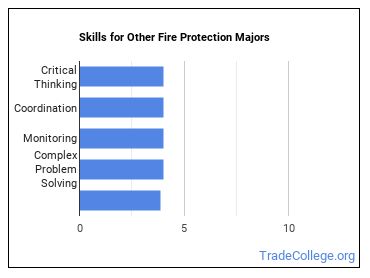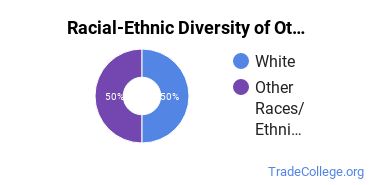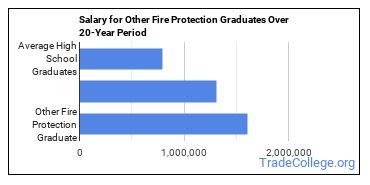Find Trade Colleges
Other Fire Protection
Types of Degrees Other Fire Protection Majors Are Getting
The following table lists how many other fire protection graduations there were for each degree level during the last year for which data was available.
| Education Level | Number of Grads |
|---|---|
| Basic Certificate | 88 |
| Bachelor’s Degree | 35 |
| Associate Degree | 7 |
What Other Fire Protection Majors Need to Know
O*NET surveyed people in occupations related to other fire protection and asked them what knowledge areas, skills, and abilities were important for their jobs. The responses were rated on a scale of 1 to 5 with 5 being most important.
Knowledge Areas for Other Fire Protection Majors
Other Fire Protection majors often go into careers in which the following knowledge areas are important:

- Public Safety and Security - Knowledge of relevant equipment, policies, procedures, and strategies to promote effective local, state, or national security operations for the protection of people, data, property, and institutions.
- Customer and Personal Service - Knowledge of principles and processes for providing customer and personal services. This includes customer needs assessment, meeting quality standards for services, and evaluation of customer satisfaction.
- Building and Construction - Knowledge of materials, methods, and the tools involved in the construction or repair of houses, buildings, or other structures such as highways and roads.
- English Language - Knowledge of the structure and content of the English language including the meaning and spelling of words, rules of composition, and grammar.
- Administration and Management - Knowledge of business and management principles involved in strategic planning, resource allocation, human resources modeling, leadership technique, production methods, and coordination of people and resources.
Skills for Other Fire Protection Majors
other fire protection majors are found most commonly in careers in which the following skills are important:

- Critical Thinking - Using logic and reasoning to identify the strengths and weaknesses of alternative solutions, conclusions or approaches to problems.
- Coordination - Adjusting actions in relation to others’ actions.
- Monitoring - Monitoring/Assessing performance of yourself, other individuals, or organizations to make improvements or take corrective action.
- Complex Problem Solving - Identifying complex problems and reviewing related information to develop and evaluate options and implement solutions.
- Social Perceptiveness - Being aware of others’ reactions and understanding why they react as they do.
Abilities for Other Fire Protection Majors
A major in other fire protection will prepare for your careers in which the following abilities are important:

- Problem Sensitivity - The ability to tell when something is wrong or is likely to go wrong. It does not involve solving the problem, only recognizing there is a problem.
- Information Ordering - The ability to arrange things or actions in a certain order or pattern according to a specific rule or set of rules (e.g., patterns of numbers, letters, words, pictures, mathematical operations).
- Oral Expression - The ability to communicate information and ideas in speaking so others will understand.
- Deductive Reasoning - The ability to apply general rules to specific problems to produce answers that make sense.
- Oral Comprehension - The ability to listen to and understand information and ideas presented through spoken words and sentences.
What Can You Do With a Other Fire Protection Major?
Below is a list of occupations associated with other fire protection:
| Job Title | Job Growth Rate | Median Salary |
|---|---|---|
| Municipal Fire Fighting and Prevention Supervisors | 7.1% | $76,330 |
Who Is Getting an Associate’s Degree in Other Fire Protection?
Racial-Ethnic Diversity
At the countrywide level, the racial-ethnic distribution of other fire protection majors is as follows:

| Race/Ethnicity | Number of Grads |
|---|---|
| Asian | 0 |
| Black or African American | 1 |
| Hispanic or Latino | 1 |
| White | 4 |
| International Students | 0 |
| Other Races/Ethnicities | 1 |
How Much Do Other Fire Protection Majors Make?
Salaries According to BLS
Other Fire Protection majors often go into careers with median salaries of $80,310. This median refers to all degree levels, so you may expect those with a more advanced degree to make more while those with less advanced degrees will typically make less.
To put that into context, according to BLS data from the first quarter of 2020, the typical high school graduate makes between $30,000 and $57,900 a year (25th through 75th percentile). The average person with a bachelor’s degree (any field) makes between $45,600 and $99,000. Advanced degree holders make the most with salaries between $55,600 and $125,400.
Amount of Education Required for Careers Related to Other Fire Protection
Some careers associated with other fire protection require an advanced degree while some may not even require a bachelor’s. In general, the more advanced your degree the more career options will open up to you. However, there is significant time and money that needs to be invested into your education so weigh the pros and cons.
How much schooling do you really need to compete in today’s job market? People currently working in careers related to other fire protection have obtained the following education levels.

| Education Level | Percentage of Workers |
|---|---|
| Less than a High School Diploma | 1.2% |
| High School Diploma - or the equivalent (for example, GED) | 34.2% |
| Post-Secondary Certificate - awarded for training completed after high school (for example, in agriculture or natural resources, computer services, personal or culinary services, engineering technologies, healthcare, construction trades, mechanic and repair technologies, or precision production) | 16.3% |
| Some College Courses | 13.0% |
| Associate’s Degree (or other 2-year degree) | 22.5% |
| Bachelor’s Degree | 12.1% |
| Post-Baccalaureate Certificate - awarded for completion of an organized program of study; designed for people who have completed a Baccalaureate degree but do not meet the requirements of academic degrees carrying the title of Master. | 0.7% |
| Post-Doctoral Training | 0.1% |
Online Other Fire Protection Programs
The following table lists the number of programs by degree level, along with how many schools offered online courses in the field.
| Degree Level | Colleges Offering Programs | Colleges Offering Online Classes |
|---|---|---|
| Certificate (Less Than 1 Year) | 0 | 0 |
| Certificate (1-2 years) | 2 | 0 |
| Certificate (2-4 Years) | 0 | 0 |
| Associate’s Degree | 4 | 0 |
| Bachelor’s Degree | 2 | 1 |
| Post-Baccalaureate | 0 | 0 |
| Master’s Degree | 1 | 0 |
| Post-Master’s | 0 | 0 |
| Doctor’s Degree (Research) | 0 | 0 |
| Doctor’s Degree (Professional Practice) | 0 | 0 |
| Doctor’s Degree (Other) | 0 | 0 |
Is a Degree in Other Fire Protection Worth It?
The median salary for a other fire protection grad is $80,310 per year. This is based on the weighted average of the most common careers associated with the major.
This is 101% more than the average salary for an individual holding a high school degree. This adds up to a gain of about $808,200 after 20 years!

Explore Major by State
Alabama
California
District of Columbia
Idaho
Kansas
Maryland
Mississippi
Nevada
New York
Oklahoma
South Carolina
Utah
West Virginia
Alaska
Colorado
Florida
Illinois
Kentucky
Massachusetts
Missouri
New Hampshire
North Carolina
Oregon
South Dakota
Vermont
Wisconsin
Trades Related to Other Fire Protection
You may also be interested in one of the following majors related to other fire protection.
| Major | Number of Grads |
|---|---|
| Fire Science | 8,321 |
| Fire Prevention & Safety Technology/Technician | 3,862 |
| Fire Services Administration | 1,370 |
| Wildl&/Forest Firefighting & Investigation | 76 |
| Fire Systems Technology | 72 |
| Fire/Arson Investigation & Prevention | 60 |
References
*The racial-ethnic minorities count is calculated by taking the total number of students and subtracting white students, international students, and students whose race/ethnicity was unknown. This number is then divided by the total number of students at the school to obtain the racial-ethnic minorities percentage.
- College Factual
- College Scorecard
- National Center for Education Statistics
- O*NET Online
- U.S. Bureau of Labor Statistics
- Usual Weekly Earnings of Wage and Salary Workers First Quarter 2020
More about our data sources and methodologies.
Featured Schools
 Request Info
Request Info
|
Southern New Hampshire University You have goals. Southern New Hampshire University can help you get there. Whether you need a bachelor's degree to get into a career or want a master's degree to move up in your current career, SNHU has an online program for you. Find your degree from over 200 online programs. Learn More > |
